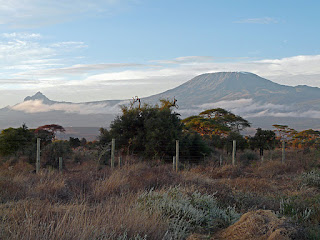We spent the morning learning about the modern life in a
Maasai village. Chief Joseph is chief Joseph is chief for a community of 600 people in 13 villages. He is r2 years old, the oldest son of a village of 4 families in one corral, but accepted as chief by other villages in the area. Historically the Maasai are semi-momadic, moving when the grass and water for their cattle fail them. But they have decided to build a permanent village near the elementary school. The warriors move the cattle and may spend a month away from the village. For Maasai wealth is measured by the number of cows they own. But last year, the village's herd declined from 300 to 30 because of the extreme drought.
The men showed how they made fire by friction between an acacia branch and a base of red cedar. They first heat up some goat, cow, zebra, or donkey dung which is crushed into a powder. From there, they light straw and finally wood.
We walked one of the kindergarten boys from the village to the school. Children start school between ages 4-7, when they are old enough to safely walk to schools which might be up to 10 km away. Amboseli elementary has 305 students from kindergarten to eighth grade and includes a dormitory to board students who live 10-14 km away. Students arrive about 7 AM and classes start after the 8 AM assembly. Lessons are in Swahili for the lower grades and English for grades 408. Their native language is Masaai. The standard curriculum is English, Swahili, science, math, social studies, life skills, physical education, and either Christianity or Islam. Depending on you exam scores, you could attend one of 3 styles of high school. But it costs about $300/year which many families can't afford and the nearest high school is 32 km. away, so they must board there. The school was founded in 1992 and new buildings sere built in 2008 by a German donor. OAT just finished a well for the school (the nearest well is 10 km. away) and is finishing one for the nearby village. There next big project is to fence in the school to protect the overnight boarders from animals. School supplies and uniforms are also a problem. We brought a gross of pens which were immediately distributed (they cost $1 each there).
We watched the morning assembly when the Kenyan flag was raised and the anthem sung. The teachers admonished the students to keep the classrooms and toilets clean. They sang us a song and we in turn sang Swing Low Sweet Chariot and Mary had a Little Lamb. The students were taking their mid-term exams that day, we couldn't observe a class, but we did have time to interact with the fifth graders. They asked who our President was, reminding us that Obama's father was Kenyan, how old we were, how many children we had. And we in turn asked about their subjects in school, how big their family was and what they would like to be. They wanted to borrow our watches, asked for pens, and wanted to get their picture taken and take our picture. Technology obviously fascinated them.
We noticed that our guide, Moses, had sandals made from a motorcycle tire and shaped so you couldn't tell which direction he was walking. This turned out to be the common footwear. We visited inside one of their homes. The frame was made of Acacia wood with cow dung walls, cow skins or plastic formed the bottom layer of the roof, with buffalo grass above (to reflect sunlight) and branches on top to hold the grass. The women could build a house in 3 months and it lasts six years. The house has just 2 rooms, one for the parents, the other for the kids and cooking. It was very dark inside since light came only through a fist size hole in the wall, which also served as the chimney. Our house had 2 small beds about the size of a couch with a cow hide mattress, three kids slept in one bed and two in the other.
After lunch, I went to the viewing platform to watch 5 elephants throwing dust for the bugs and drinking from a waterhole. On our afternoon drive we saw the usual antelope and zebra. We also saw
guinea hens crossing the road. Then spent most of the time watching two cheetah who were eyeing some Thompson Gazelle. We thought they would give chase, but after a little stalking, they laid back down, but they sure attraced a lot of vehicles! We ended the drive watching the elephants, saw some tussles between young bulls and capped the evening with elephants framed by Mt. Kilomanjaro.






























 Reconstructed Great Kiva
Reconstructed Great Kiva







